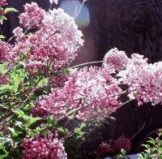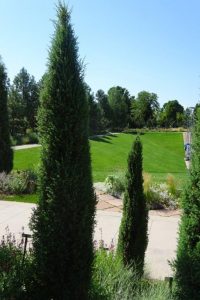 In late June Eve and Mikl attended two inspiring events that are related in that both organizations / institutions are concerned with researching, trialing, and introducing plants that are resilient in the face of the challenges presented by Climate Change, especially increasing heat and long-term drought.
In late June Eve and Mikl attended two inspiring events that are related in that both organizations / institutions are concerned with researching, trialing, and introducing plants that are resilient in the face of the challenges presented by Climate Change, especially increasing heat and long-term drought.
The first event was the annual conference of the Plant Select® program, celebrating 25 years of their work. Through the collective efforts of Denver Botanic Gardens, CSU Horticulture department, and members of the region’s ‘green industry’, Plant Select is a non-profit Western plant introduction program dedicated to “creating smart plant choices inspired by the Rocky Mountain region”. Thus far, Plant Select® has introduced more than 170 plants that are either new to horticulture or underused by gardeners and landscape professionals. As active members of Plant Select®, we attend meetings suggest and discuss potential introductions, and evaluate plants that are growing in the test plots. We are also a licensed propagator for Plant Select plants.
 This year’s conference theme was Resilience in a Time of Climate Change. The direction of Plant Select’s® focus is toward exceptional heat-tolerant plants that can handle long-term drought. The most exciting presentation was Crevice Gardens and Their Use in the Dry West, given by rising horticultural star, Kenton Seth of Grand Junction, CO. Kenton showed and discussed crevice gardens around the region and the world, their diverse uses in our region, and how you can leverage these beautiful gardens to solve specific problems of the dry American West. Look for Kenton’s soon-to-be-released book, The Crevice Garden: How to Make the Perfect Home for Plants from Rocky Places, arriving soon to Harlequin’s Gardens!
This year’s conference theme was Resilience in a Time of Climate Change. The direction of Plant Select’s® focus is toward exceptional heat-tolerant plants that can handle long-term drought. The most exciting presentation was Crevice Gardens and Their Use in the Dry West, given by rising horticultural star, Kenton Seth of Grand Junction, CO. Kenton showed and discussed crevice gardens around the region and the world, their diverse uses in our region, and how you can leverage these beautiful gardens to solve specific problems of the dry American West. Look for Kenton’s soon-to-be-released book, The Crevice Garden: How to Make the Perfect Home for Plants from Rocky Places, arriving soon to Harlequin’s Gardens!

Syringa microphylla Cheyenne (Cheyenne Littleleaf Lilac). Photo Credit, Ft. Collins Wholesale Nursery
Our second outing was a tour of the High Plains Arboretum, formerly known as the USDA High Plains Horticultural Station, or the Cheyenne Horticultural Research Station, at 6,200’ elevation, north of Cheyenne, WY. With many successful plant introductions, it is one of the nation’s important historic horticultural sites. The original intent and purpose of the facility, opened in 1928, was to find, plant, test, breed and release trees, shrubs, and flowers from around the world for their ability to prosper in the harsh, challenging conditions of the high, arid, windy West. Between 1929 and the station’s closing in 1976, many thousands of shrubs and trees were planted in the 2,870-acre tract. A surprising number of these plantings are so well adapted that they are still alive and well after decades of abandonment. Some care and watering was restored in recent years, and currently both the Cheyenne Urban Forestry division and Cheyenne Botanic Gardens are working to preserve the existing plants, restore plantings, and add new plants of note in a section of 62 acres of what was once woody plant research blocks.

Juniperus scopulorum ‘Woodward®’ (Woodward Juniper)
The tour was led by our good friend, Scott Skogerboe, plant explorer and longtime head propagator for Fort Collins Wholesale Nursery. Decades ago, Scott made a connection with the Cheyenne Station when he befriended the last director of the station and began researching their voluminous records and making many visits there to observe the performance of the hundreds of exotic and native specimens still thriving in that untended, dry, windy environment. Scott is responsible for bringing some of the best of them into our gardens, through both Fort Collins Wholesale Nursery and the Plant Select® program: “Cheyenne®” Mockorange, “Cheyenne” Littleleaf Lilac, ‘Tidy®’ Peashrub, ‘Little Max’ Peashrub, ‘Woodward®’ Juniper, and more. Scott is a storyteller at heart, and shared many fascinating and sometimes humorous observations, histories, and anecdotes with us.
It is heartening to witness the change in direction of plant introduction and promotion, which for so many years was mostly about novelty and ornamental qualities rather than disease and pest-resistance, durability, and resilience. The purpose of gardening in our times should be morphing from just making a pretty picture to providing environmental benefit on many levels.
